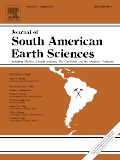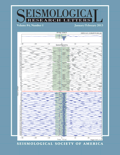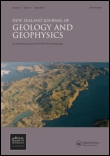
Quaderni di Geofisica
Scope & Guideline
Illuminating the Path of Geophysical Discovery
Introduction
Aims and Scopes
- Seismic Activity and Earthquake Cataloging:
The journal extensively covers seismic events, focusing on cataloging historical earthquakes in Italy and analyzing their impact. This includes updating existing catalogs and providing new insights into lesser-known seismic events. - Volcanology and Monitoring:
Research on volcanic activity, especially concerning Mt. Etna, is a significant theme. The journal publishes studies on seismicity related to volcanic eruptions and the effectiveness of early warning systems. - Geophysical Methodologies and Technologies:
Innovative methodologies for monitoring seismic activity, such as the use of UAVs for point cloud analysis and the development of calibration systems for seismic sensors, are regularly featured. This reflects the journal's commitment to integrating technology with geophysical research. - Interdisciplinary Studies:
The integration of geophysics with other disciplines, such as environmental science and risk communication, highlights the journal's aim to address the broader implications of geophysical phenomena on society and the environment.
Trending and Emerging
- Enhanced Earthquake Early Warning Systems:
Recent publications emphasize the development and performance of early warning systems for earthquakes, showcasing a growing interest in improving real-time monitoring and response strategies to mitigate earthquake impacts. - Comprehensive Cataloging of Minor Earthquakes:
There is an increasing trend in documenting minor seismic events, particularly in localized areas like Northern Italy. This focus on detailed cataloging enhances our understanding of regional seismicity and its implications. - Interdisciplinary Approaches to Risk Communication:
The emergence of studies addressing communication and education related to seismic risk indicates a trend towards integrating social sciences with geophysical research, aiming to improve public awareness and preparedness. - Geothermal Induced Seismicity:
The examination of geothermal energy production and its impact on seismic activity is gaining traction, reflecting a growing concern for the environmental implications of energy extraction and the need for effective monitoring.
Declining or Waning
- Historical Seismology Beyond Italy:
While historical earthquakes are a focus, the emphasis on earthquakes outside Italy appears to be diminishing. Recent publications have primarily concentrated on Italian seismic events, resulting in less comparative historical seismology on a global scale. - Electromagnetic Precursors:
The exploration of electromagnetic phenomena associated with seismic events, although still present, has seen a decline in the number of dedicated studies. This suggests a potential shift in focus towards more traditional seismic monitoring techniques. - Geophysical Phenomena Related to Non-Seismic Events:
Research connecting geophysical phenomena, such as electric and magnetic events, to seismicity has become less prominent. This may indicate a narrowing of interest towards more direct seismic studies rather than broader geophysical correlations.
Similar Journals

JOURNAL OF SOUTH AMERICAN EARTH SCIENCES
Connecting Past and Present in Earth SciencesJOURNAL OF SOUTH AMERICAN EARTH SCIENCES is a premier interdisciplinary journal dedicated to publishing high-quality research in the fields of Earth-Surface Processes, Geology, and Paleontology, making it an essential resource for scientists and researchers focused on South American geology and its diverse geological phenomena. Published by Pergamon-Elsevier Science Ltd in the United Kingdom, this journal has been instrumental in disseminating groundbreaking studies since 1988, showcasing contributions that push the boundaries of knowledge in Earth and Planetary Sciences. With an impressive Scopus ranking—positioning it in the 74th percentile for Paleontology and 71st for Geology—this journal not only reflects robust academic quality but also its commitment to addressing critical geological challenges in South America. Researchers will appreciate its objective of advancing understanding of geological processes while providing insights into past, present, and future Earth environments. Although available through traditional subscription models, the journal's vast repository of articles enriches the academic landscape, facilitating the sharing of vital research among professionals, students, and geological practitioners.

Earthquake Science
Fostering Global Collaboration in Seismic StudiesEarthquake Science is a prominent open access journal that has been serving the scientific community since its inception in 2009, published by KEAI PUBLISHING LTD. With an ISSN of 1674-4519 and an E-ISSN of 1867-8777, this journal has established itself as a significant platform for the dissemination of research in the fields of geology, geophysics, and geotechnical engineering, evident from its Q2 ranking in 2023 across these categories. Based in China, Earthquake Science aims to facilitate knowledge sharing and foster interdisciplinary collaboration by publishing a range of high-quality articles, reviews, and research papers demonstrating advancements in understanding seismic activity and its impacts. Its commitment to open access since 2015 ensures that valuable insights are available to researchers, professionals, and students globally, thereby supporting critical inquiries into earthquake mechanisms and risk management strategies. Explore the latest findings and contribute to the ongoing conversation in the evolving landscape of earthquake science.

SEISMOLOGICAL RESEARCH LETTERS
Pioneering insights into the dynamic world of earthquakes.SEISMOLOGICAL RESEARCH LETTERS is a leading journal in the field of geophysics, published by the Seismological Society of America. With its ISSN 0895-0695 and E-ISSN 1938-2057, this prestigious publication serves as a vital platform for disseminating groundbreaking research and advancements in seismological science. The journal boasts an impressive Q1 categorization in the 2023 rankings and ranks 23rd out of 165 in Earth and Planetary Sciences, Geophysics, placing it within the 86th percentile among its peers. Spanning an illustrious history from its origination in 1984 to its ongoing contributions through 2024, it is dedicated to fostering a deeper understanding of seismic phenomena. Although it currently does not offer open access, researchers, professionals, and students can benefit from timely insights and comprehensive studies presented in its pages. Set within the heart of the United States, the journal stands as a cornerstone in geophysics, connecting a global community eager to advance their knowledge and impact in the field.

BULLETIN OF VOLCANOLOGY
Charting the Course of Volcanic ScienceBULLETIN OF VOLCANOLOGY, an esteemed journal published by Springer, serves as a vital platform for disseminating cutting-edge research in the field of volcanology and related geosciences. With its ISSN 0258-8900 and E-ISSN 1432-0819, this journal has garnered a reputation for excellence, evidenced by its Q1 ranking in Geochemistry and Petrology as of 2023, and its impressive Scopus rank of #39 out of 154 in Earth and Planetary Sciences. Established in 1930 and spanning converged years until 2024, the journal has continuously provided researchers, professionals, and students a comprehensive view into volcanic processes, their impacts on the environment, and the implications for climate change. Although not open access, the valuable insights and groundbreaking studies published within its pages ensure that BULLETIN OF VOLCANOLOGY is indispensable for those seeking to deepen their understanding of the dynamic Earth.

GEOTECTONICS
Exploring Earth's Mysteries, One Tectonic Shift at a Time.GEOTECTONICS is a distinguished academic journal published by PLEIADES PUBLISHING INC, focusing on key developments in the field of geology. Established in 1978, the journal has dedicated itself to exploring the intricate processes and phenomena associated with Earth's tectonic systems, making substantial contributions to Earth and Planetary Sciences. With an impressive impact factor reflected in its Q2 ranking within the Scopus category of Geology, GEOTECTONICS stands out as a valuable resource for researchers, professionals, and students alike. The journal offers a platform for rigorous peer-reviewed research that spans both fundamental theories and practical applications in geosciences, affirming its significance in fostering academic discourse and advancing geological knowledge. Although it currently does not offer open access, the journal's accessible format and continued publication through to 2024 ensures that it remains at the forefront of geoscientific inquiry.

NEW ZEALAND JOURNAL OF GEOLOGY AND GEOPHYSICS
Illuminating the Complexities of Our Planet's Processes.NEW ZEALAND JOURNAL OF GEOLOGY AND GEOPHYSICS, published by Taylor & Francis Ltd, stands as a prominent forum dedicated to the interdisciplinary exploration of geological and geophysical phenomena. With an impact factor that situates this journal in the prestigious Q1 category across key subjects—namely Earth and Planetary Sciences, Geology, and Geophysics—it is a critical resource for researchers, professionals, and students alike. The journal has been operational since 1958 and continues to contribute valuable insights into the complexities of the Earth's processes. Although it does not currently offer Open Access options, its broad readership benefits from an extensive archive of high-quality research findings that span from 1958 to 2024. Located in the United Kingdom, the journal remains a pivotal player in advancing the understanding of Earth's systems, making significant contributions to both academic inquiry and practical applications in the field.

JOURNAL OF SEISMOLOGY
Advancing seismic understanding through rigorous research.Welcome to the JOURNAL OF SEISMOLOGY, an esteemed publication in the field of Earth sciences, dedicated to the study of seismic phenomena and their implications on geophysical and geochemical processes. Published by SPRINGER and based in the Netherlands, this journal has been contributing to the academic community since 1997 and is set to continue through 2024. With an impressive ranking within the quartiles—Q2 in Geophysics and Q3 in Geochemistry and Petrology for 2023—this journal is a pivotal resource for researchers and professionals seeking to expand their understanding of seismic activities, earthquake mechanics, and related geological interactions. Despite not offering open access, it remains a highly regarded platform for disseminating rigorous research and findings in Earth and Planetary Sciences, sustaining a global readership keen on advancing their knowledge in this dynamic field. The JOURNAL OF SEISMOLOGY is committed to fostering scholarly exchange and advancing scientific inquiry, making it an invaluable asset for students, researchers, and professionals alike.

Seismic Instruments
Transforming seismic studies with high-quality research insights.Seismic Instruments is a prestigious academic journal dedicated to advancing the field of geophysical instrumentation and its applications in seismic studies. Published by PLEIADES PUBLISHING INC, this journal serves as a crucial resource for researchers, professionals, and students interested in the development, evaluation, and deployment of seismic instrumentation technologies. Although it does not currently offer open access, it provides a comprehensive platform for high-quality research articles, reviews, and technical notes that explore the latest innovations and findings in seismic studies. With an ISSN of 0747-9239 and an E-ISSN of 1934-7871, Seismic Instruments aims to foster collaboration and knowledge exchange among the global academic community, emphasizing the importance of instrumentation in understanding seismic activity and its implications for engineering, environmental science, and hazard mitigation.

GEOSCIENCES JOURNAL
Charting New Territories in Earth and Environmental Science.Welcome to the GEOSCIENCES JOURNAL, a pivotal publication in the fields of Earth and Planetary Sciences and Environmental Science, proudly presented by the Geological Society of Korea. Established in 1997, this journal has become a prominent platform for researchers, professionals, and students, offering a rich collection of peer-reviewed articles that explore a diverse array of geoscientific topics. With an impressive Q2 ranking in both Earth and Planetary Sciences and Environmental Science categories for 2023, it stands as an essential resource in the academic community. Though it operates under a traditional subscription model, GEOSCIENCES JOURNAL remains dedicated to advancing knowledge through rigorous research. Addressed from its headquarters in Seoul, South Korea, the journal aims to foster a deeper understanding of geosciences, encouraging innovation and collaboration in tackling today’s environmental challenges.

Geofisica Internacional
Bridging Knowledge Gaps in Geophysics and Environmental ScienceGeofisica Internacional, an esteemed academic journal published by the Instituto de Geofísica at UNAM, Mexico's prestigious National Autonomous University, has been a pivotal platform for advancing the field of geophysics and energy studies since its inception in 1975. This Open Access journal aims to disseminate high-quality research findings, making significant contributions to our understanding of Earth's processes and energy resources. With a current impact factor that situates it in the Q3 category for both Energy (miscellaneous) and Geophysics, it provides a continuous dialogue for researchers, professionals, and students interested in the intersection of these critical areas. Based in Mexico City and publishing articles that span various geophysical disciplines, Geofisica Internacional is indispensable for anyone seeking to stay at the forefront of environmental and energy research.